Temple House
Houses within 15km of this house
Displaying 87 houses.
Houses within 15km of Temple House
Displaying 87 houses.
| House name | Description | |
|---|---|---|
| Seafield or Lisheen | At the time of Griffiths Valuation, William Phibbs owned a house at Lisheenacooravan valued at £55. This house was known as Seafield or Lisheen at different times. In 1906 Seafield/Lisheen was valued at £55. The property is now a ruin |

|
| Chaffpool | Chaffpool House was the centre of the Armstrong estate in the 19th century having previously belonged to the Somers family. At the time of Griffith's Valuation it was owned by Catherine Armstrong and was valued at £35. In 1906 it was occupied by the representatives of Edward Armstrong and was valued at £49. It was also recorded as a seat of the Armstrong family by Lewis in 1837. Extensive remains of walled garden, stable and a later (c.1890s) house remain. |

|
| Streamstown | Streamstown House was an important seat of the Irwin family in the eighteenth century. McTernan writes that it was a centre of gaiety and music and enjoyed visits from the well known harper, Arthur O'Neill. In 1786 Wilson refers to it as the seat of "Mr. Irvine". From the early nineteenth century, however, the family tended to reside elsewhere and Streamstown was usually occupied by a steward or herdsman, At the time of Griffith's Valuation, Henry Irwin was in possession of the property at Streamstown, which consisted of a herd's house and a gatehouse. It was valued at almost £2. In 1894 Slater still refers to it as a residence of Burton Irwin. Only one gable and a chimney of the house remain. | |
| Doobeg | At the time of Griffith's Valuation the property at Doobeg consisted of a herd's house, valued at over £1, together with over 300 acres, and was in the ownership of Robert McAlpine. In the later nineteenth century it was lived in by the Phibbs family. Doobeg house is still extant and occupied as a family home. | |
| Breeogue | Matthew Walsh was leasing this property from the Earl of Erne's estate at the time of Griffith's Valuation when it was valued at almost £6. Breeogue House is still extant and occupied. |

|
| Mount Irvine or Mount Irwin | At the time of Griffith's Valuation Edward B. Thornhill held over 300 acres including the townland of Mount Irvine and a property described as offices, valued at £3. Lewis had recorded Mount Irvine as the seat of William T. Sherlock in 1837. This house is more usually known as Mount Irwin and was a seat of the Irwin family in the eighteenth century. It passed by marriage to the Thompsons and then to William Theophilus Sherlock. It was later sold in the Encumbered Estates Court and the Thornhills continued to own it until 1907 when it was sold to the Land Commission. Nothing remains of the original house. | |
| Cuilmore | At the time of Griffith's Valuation, James Powell was leasing a property valued at £7 with over 150 acres, from Lord de Freyne's estate, at Cuilmore, barony of Coolavin. The original house is not extant now. | |
| Flower Hill | Flower Hill was being leased by Magdalene Irwin from the Perceval estate at the time of Griffith's Valuation when it was valued at £3. The Irwins had a modest house at this location and in the 1820s set about building a larger property. Due to debt and court proceedings it was never finished and remains a roofless ruin. | |
| Roadstown | At the time of Griffith's Valuation Charles O'Connor was leasing the property at Roadstown, barony of Corran from Rev. William Hearne and Capt. Starke, when it was valued at £6.Lewis also records it as the seat of the O'Connor family. In the eighteenth century Roadstown was associated with the Fleming family some of whom are buried in the churchyard of Emlaghfad, near Ballymote. Roadstown House is still standing but derelict. The house and farm were sold in 2005. |

|
| Old Rock | At the time of Griffith's Valuation John Trumble was leasing a property valued at £4 at Old Rock, barony of Corran, from Johnston Parke. McTernan states that John Trumble eventually disposed of his interest in this property and settled in Manchester. The original house is no longer extant. | |
| Greyfort | Alexander Perceval was the lessor of a property valued at almost £6 at Lislea, barony of Corran, which he was leasing to James Dale at the time of Griffith's Valuation. McTernan notes the house as the seat of the Rea family from the mid-seventeenth to the mid-nineteenth centuries. A number of other families occupied the house up until the 1980s when it was demolished. | |
| Abbeyville | Abbeyville was originally a Phibbs property. McTernan states that it was leased to William Fleming after the death of William Phibbs in 1785.The original house was built in 1716 but extensively modernised afterwards. In 1814 it was the residence of William Fleming. At the time of Griffith's Valuation it was being leased by James Fleming from William Phibbs and was valued at £6. In the later nineteenth century it passed out of the Fleming family. It was demolished in the later twentieth century. Leet indicates that Archibald Fleming resided at Larkfield, also close to Ballymote. | |
| Drimrane | At the time of Griffith's Valuation John Taaffe was leasing a property at Drimraine, barony of Corran, valued at £6 to John Davis. It was in use as a herd's house accompanying a holding of over 100 acres. McTernan states that Davies subsequently sold the property to the Reynolds family in whose possession it still remains. | |
| Cloonshanbally | Margaret and Henry Gorman were leasing a property valued at £12 at Cloonshanbally, barony of Tirerrill, from the Gore Booth estate at the time of Griffith's Valuation. | |
| Earlsfield | Earlsfield had earlier been a Dodwell property. At the time of Griffith's Valuation it was leased from the Gore-Booth estate by Capt. Richard Gethin and was valued at £20. Slater records it as the seat of Francis Gethin in 1894. It is still extant and has served as a convent for many years. |

|
| Carrowkeel | At the time of Griffith's Valuation John F. MacDonagh held property valued at £12 at Carrowkeel, barony of Corran, from the Gore Booth estate. Lewis also records this as a MacDonagh property, describing it as a "fine modern residence". McTernan notes that Carrowkeel was probably built by Francis MacDonagh at the beginning of the nineteenth century. It remained in the family until its sale in the Landed Estates Court. It is still extant and occupied. | |
| Newpark | At the time of Griffith's Valuation Newpark was being leased by Jemmet Duke from Robert Duke and was valued at £25. Lewis recorded it as the seat of Robert Duke in 1837. McTernan notes that it passed by sale to Richard Edward O'Hara of the Annaghmore family in 1913. The house is still extant and occupied by his descendents. |

|
| Doocastle Cottage | In Griffith's Valuation Joseph M. McDonnell held Doocastle Cottage from John B. Lindsey [of Turin Castle, barony of Kilmaine] when it was valued at £10. It is now a ruin. | |
| Battlefield | McTernan notes that Battlefield was built for the Knott family in the early nineteenth century. At the time of Griffith's Valuation James Knott occupied the property, then valued at £20. Both Leet in 1814 and Lewis in 1837 record Battlefield as a residence of the Knott family. In the later nineteenth century the house passed into the ownership of the Robinson family, descendents of the Knotts. with whom it remained until the 1940s. It was sold and subsequently demolished. | |
| Kilturra | At the time of Griffith's Valuation Joseph Verscoyle was leasing a property valued at £6 together with over 300 acres to Bartholomew McGettrick, at Kilturra, barony of Corran. This later became the residence of John Ormsby Cooke. It was partially damaged by fire in 1920 and Cooke eventually abandoned the property which became derelict. It was demolished in the 1930s. | |
| Clooncunny | At the time of Griffith's Valuation Thomas Rice was leasing a property valued at £5 together with over 150 acres at Clooncunny, barony of Leyny, from the Kirkwood estate. Lewis records Thomas Rice's seat as Achonry in 1837. A house and farm are still extant at this location. | |
| Corsallagh | At the time of Griffith's Valuation Charles O'Connor was leasing a property valued at £8 together with over 250 acres at Corsallagh, barony of Leyny from John N. Farrell. Lewis records it as the seat of Dominick O'Connor in 1837. This house is no longer extant. | |
| Annaghmore (Nymphsfield) | Annaghmore has been the principal seat of the O'Haras since medieval times. An earlier house on the site had been demolished by 1684. It's successor was replaced by the present house c.1820. That house was known in the eighteenth and early nineteenth century as Nymphsfield and is described by McParlan in 1802. In 1786 Wilson refers to Nymphsfield as the pleasant seat of Mr. O'Hara. The name of the house was changed back from Nymphsfield to Annaghmore in the early 19th century and the house was further enlarged. In 1894 it was the seat of Capt. Charles K. O'Hara. In 1906 the house was valued at £68. Annaghmore is still extant and occupied by the O'Hara family. |

|
| Markree Castle | Markree Castle was built in the early nineteenth century replacing an earlier property, which McParlan indicates was known as Mercury. McTernan notes that it is the oldest residential site in the county, having been founded by Cornet Cooper in the seventeenth century. At the time of Griffith's Valuation it was owned by Edward J. Cooper and was valued at £90. By the mid twentieth century it had fallen into disrepair but was later acquired by another member of the Cooper family. It now operates as a hotel. See http://www.markreecastle.ie/history.htm for more information. In 2014 it was offered for sale. |

|
| Longford House | Longford House was built in the mid-18th century but was destroyed in a fire in the early 19th century,c1816. It is this house to which Wilson refers as the seat of Mr. Crofton in 1786. Another house was built adjacent to the original. McTernan notes that this house also suffered fire damage in both 1840 and again in 1916. At the time of Griffith's Valuation a house at Longford Demesne was valued at £13 and was the property of Sir Malby Crofton. In 1906 this was the property of Sir Malby Crofton and was valued at £30. The later Longford House is still extant and occupied. The original is an impressive ruin. |

|
| Tanrego | In 1786 Wilson writes that Mr. Irwin's property was situated "on the right of Strandhouse Inn" and nearby was Tanrago, the seat of Mr. Dodwell. At the time of Griffith's Valuation, Capt.Richard Olpherts was occupying a house at Tanrego, barony of Tireragh. In 1894 Slater refers to Tanregoe as the seat of Richard Verschoyle. In 1906 Tanrego was the property of Richard J. Verschoyle and was valued at £25. It is still extant and occupied. |

|
| Beltra Rectory | This house, part of the Irwin estate, was on perpetual lease from the Cooper estate. It principally functioned as the local rectory. At the time of Griffith's Valuation the property was occupied by Rev. St.George Knox and was valued at £13. |

|
| Clooskirt | At the time of Griffith's Valuation, Mrs. Ormsby Gore was leasing this property to William Wilson. It was then valued at £12. At the same time Ruttledge Burrowes was leasing a property valued at £4 with over 140 acres of land from the Ormsby Gore estate. Johnston states that a "model farm" was established here in the later nineteenth century. This townland is mentioned as Clooshire, in 1906, when George Ormsby Gore was the owner of the property but there is no valuation given for buildings at that time. It was subsequently lived in by the St. Lawrence family. |

|
| Rockbrook | Rockbrook was originally a Phibbs property. It later came into the possession of Abraham Martin of Cleveragh who leased it to the Cogan family and later to the Lougheed estate. It was occupied by John Lougheed at the time of Griffith's Valuation when it was valued at £3. Johnston states that the estate was divided by the Land Commission in the 1920s and that the house was sold by Mrs. Lougheed in 1938. It burnt down in 1945 and only the ruins remain today. | |
| Cloonamahon | In 1854 when the estate was offered for sale by Thomas James Meredith the house was described as "a good slated dwelling-house..somewhat out of repair, but with a little outlay, it could be made very comfortable". In 1906 Dr. Henry Tweedy was the owner of buildings valued at £50 at the site. Following the departure of the Tweedy family the property was used as a sanitorium and later a retreat centre. McTernan notes that the original house was demolished in 1976 and replaced by modern buildings. Most of the site is now occupied by a Health Service facility. | |
| Castle Neynoe/Ballysumaghan House | At the time of Griffith's Valuation, Richard B. Neynoe was leasing property at Ballysumaghan, barony of Tirerrill, to Henry Griffith, when it was valued at £30. Johnston states that Griffith changed its name to Ballysumaghan House. In 1906 it was the property of M.F.B. Stack. The house was stripped and the contents auctioned in the 1930s. Castle Neynoe was a ruin for many years but began to be restored in 2007. |

|
| Doonally | This property was sometimes known as Doonalla. At the time of Griffith's Valuation it was occupied by Mary Fury who was leasing it from Phillip Gumley when it was valued at £6. Lewis recorded it as a residence of Owen Phibbs in 1837. | |
| Lisconny | Lisconny was a property which belonged to the Phibbs family in the eighteenth century. McTernan notes that it had been purchased by them from the Mortimer family in the 1770s. It passed to the Toler family, earls of Norbury, through marriage. At the time of Griffith's Valuation, it was occupied by Bernard Owen Cogan, leasing from Lady Norbury's estate. It was then valued at £20. Lewis also records it as being occupied by the Cogan family in 1837. Johnston asserts that the Cogans acted as agents for Lady Norbury's estate in Ireland. The house was demolished early in the twentieth century. Very few traces remain except some walls of the stable yard and a building which had been an annex to the big house. | |
| Coopershill | Coopershill House was completed in 1774. McParlan described its situation as delightful in 1802. Lewis records it as the seat of Arthur Cooper in 1837. At the time of Griffith's Valuation it was occupied by Charles William Cooper and valued at £52. Charles William Cooper later succeeded his uncle as owner of the O'Hara of Annaghmore estate and henceforth Coopershill bacame an O'Hara property. He is recorded as the owner in 1894. The house is still extant and run as a guesthouse by the O'Hara family. |
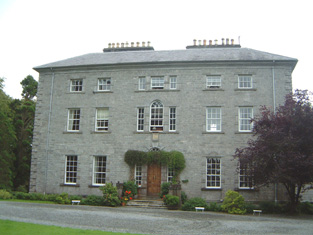
|
| Castle Dargan | At the time of Griffith's Valuation, Castle Dargan was the property of John Ormsby and was valued at £14. McTernan writes that the Ormsbys had been in possession of the lands since the seventeenth century and had lived at the "old" castle before the building of the house. In 1906 it was owned by John Hosie. It continued in the Hosie family until c.2004 when it was converted into a hotel and golf course. The house has been refurbished and is in use. See www.castledargan.com |

|
| Tobercurry | John Brett was leasing a house in the town of Tobercurry to the value of £17 from the Irwin estate at the time of Griffith's Valuation. Much development has taken place in the vicinity since then. | |
| Knockadoo | At the time of Griffith's Valuation the house at Knockadoo was occupied by Meredith Thompson and was valued at £11. McTernan indicates that it had previously been owned by the Savage family and sold to the Thompsons in the 1840s, leaseholders since the eighteenth century. In the 1880s, Knockadoo was sold to the Heather family who ran a horse-breeding business there until the 1930s when the property was acquired by the Land Commission. The house was subsequently damaged by fire but has been extensively restored in recent times. | |
| Doomore | At the time of Griffith's Valuation the house at Doomore, barony of Leyny, valued at £5, together with over 200 acres was leased by Walter Henry from John F. Knox. In 1837 Lewis lists Doomore as the residence of Hugh Gray. McTernan notes that it was held by the Gray family from the mid-eighteenth to almost the mid-nineteenth century. | |
| Spotfield | Spotfield appears to have been the property of the Phibbs family in the 19th century but in the 18th century may have been occupied by the White family who had intermarried with the Phibbs. At the time of Griffith's Valuation, it was leased by John Phibbs to Eccles Phibbs. The house was then valued at almost £4. McTernan notes that the house was demolished in the latter part of the twentieth century. | |
| Avena | McTernan indicates that this house was originally owned by Robert Culbertson, mill owner of Ballysadare. His property was purchased in the Landed Estates Court in the 1860s by Messers. Middleton and Pollexfen and became a regular residence of Wiliam Middleton. It is still extant and occupied. |
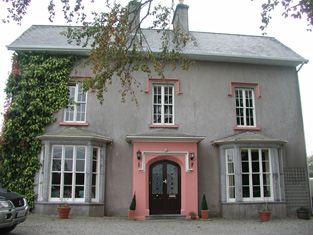
|
| Ballyara or Ballyhara | The original Ballyara Castle was formerly associated with the O'Hara family. At the time of Griffith's Valuation, Patrick Mullarkey was leasing a building valued at £3 at Ballyara, barony of Leyny, from the Ffolliott estate. | |
| Heathfield (Sligo) | The house at this site was built c.1890 presumably replacing an earlier house listed in Griffith's Valuation, when it was being leased by William Phibbs from the Cooper of Markree estate. At that time it was valued at £6. In 1906 it was owned by Thomas Randle Phibbs and was valued at £22. This later house survives and has been offered for sale in recent years. Ruins of gatelodge and gated entrance visible at G656219. |

|
| Tanzyfort | Tanzyfort House was built by the Cooper family in the mid-17th century and occupied by them until the completion of Coopershill House in 1774. Wilson, however, still refers to it as the seat of Arthur Cooper in 1786. Orser provides a detailed description of the layout of Tanzyfort House. | |
| Carrowgarry | In 1906 Alexander Crichton was the owner of Carrowgarry House, valued at £37. At the time of Griffith's Valuation, a herd's house, valued at £3 and part of the Crichton estate, was located here. |

|
| Glen Lodge | Around 1780 James Sandford Nicholson settled in the newly built family seat which he named Glen Lodge. It was in the possession of Thomas White at the time of Griffith's Valuation who was leasing it to James Coghrane when it was valued at £15. At the time the estate was sold in the Landed Estates Court in 1876 Glen Lodge is described as "a good residence, leased by the Court of Chancery to Andrew James for 7 years from 1869". The house is still extant and occupied. |

|
| Powellsborough | At the time of Griffith's Valuation, Abraham Powell, was leasing a property at Powellsborough, barony of Leyny, valued at £5 together with almost 400 acres from Edward Powell, In 1906 James J. Powell was the owner of buildings valued at £12 at Powellsborough, barony of Leyny. The Congested Districts Board later acquired over 50 acres of this estate. The house is still extant but derelict. | |
| Abbeytown | In 1906 Mrs. H. Campbell owned a property valued at £5 as well as over 100 acres of untenanted land at Abbeytown, [Grid reference is approximate] | |
| Mount Dodwell | Henry Crichton was the owner of a property valued at almost £7 at Ballinvoher, barony of Corran, in 1906. This may be the cottage which is still extant and was possibly a steward's house. At the time of Griffith's Valuation, it was being leased by Samuel Gilmore from the Creighton estate and was valued at £5. Lewis records Mount Dodwell as the residence of Charles Thompson, who was related to the Dodwell family. This was the original house, which had stood here since the eighteenth century. It ceased to be a residence in the mid-nineteenth century and was subsequently demolished. |

|
| Union | In 1906 Col. E.H Cooper's estate owned a property at Union, barony of Tirerrill, valued at £7. This may the gamekeeper's cottage which is still extant at this location. |

|
| Toberscanavan House | At the time of Griffith's Valuation, James Noble was leasing this property, valued at £3 from the Cooper estate. McTernan notes that it remained in the Noble family until the later twentieth century. It is still extant but derelict. |

|
| Carrick House | Johnston states that Carrickcoola was owned by the Ormsby Gore estate but was the residence of the McLoghrey family. McTernan indicates that the original house was of two stories but that this was later replaced by a single storey building. The Ormsby Gore estate owned 22 acres of untenanted land in Carrickcoola, barony of Tirerrill, in 1906 but the buildings are not listed. At the time of Griffith's Valuation, Maj. Ormsby Gore owned the townland and was leasing a house valued at only 10s to Thomas McCloghrey together with over 130 acres. | |
| Kingston Lodge | Johnston states that Kingston Lodge was a residence of the McLoghry family. McTernan notes that it is a mid to late nineteenth century building, built by Henry McCloghry, son of Thomas McClogry of Carrickcoola. It was being leased by him from the Cooper estate at the time of Griffith's Valuation and valued at almost £4. The house remained in the McCloghry family until the 1940s and is now in a derelict state. | |
| Ardagh | At the time of Griffith's Valuation Richard Graves Brinkley held extensive property at Ardagh and Bellanascarva, barony of Tirerrill. This had formerly been part of his wife, Hester Lloyd's estate. Ardagh House was then valued at £14. Johnston states that the property at Ardagh was later lived in by Hunter family who acted as agents for the Brinkley estate. Part of the extensive farmyard of Ardagh House has been converted into residential accommodation. An extensive mill complex in the nearby townland of Bellanascarva was leased to Munds Harper at the same time where Brinkley also held a house valued at £30. |

|
| Lissycoyne | At the time of Griffith's Valuation, Patrick McDermott was leasing a property valued at £7 at Lissycoyne, barony of Tirerrill, from the Brinkley estate. It is shown as diminished in size on the 25-inch Ordnance Survey map of the 1890s. Some farm buildings are located at the site now. | |
| Carrowcrin | The Census of Elphin records Robert Burrowes as resident at Caracin in 1749. Johnston Burrowes was leasing a property valued at £3 to the Beatty family at Carrowcrin, barony of Tirerrill at the time of Griffith's Valuation. McTernan states that the property remained in the Burrows family until the early 1900s. It became vacant after the last of the family died and was eventually converted into farm-buildings. | |
| Carnaleck or Carrownaleck | At the time of Griffith's Valuation John Gray was leasing a property valued at £8 together with 178 acres from Adam Mossman at Carrownaleck, barony of Leyny. This would originally have been part of the Nicholson estate. McTernan notes that the Grays surrendered their lease in the 1880s. The property is still extant and occupied. | |
| Bellamont House | Archaeological research would appear to indicate that Richard Coote had a fortified house at Collooney sometimes referred to as Bellamont House or Collooney Castle. A later structure in the town, also known as Bellamont House, is not associated with the Coote family. A possible site for Collooney Castle has been identified by Timoney drawing on earlier sources such as Terence O'Rorke. | |
| Atteville | Both Leet and Lewis indicate that Atteville was the seat of the Knott family with William residing there in 1814. At the time of Griffith's Valuation the property was in the possession of William Phibbs. It is described as a "herd's house" and was valued at almost £2. | |
| Branchfield (Duke) | At the time of Griffith's Valuation Alexander Duke was leasing property valued at £8 with almost 300 acres, at Branchfield, barony of Corran, from Jemmet Duke. Lewis records Branchfield as the seat of Rev. William Duke in 1837. Wilson notes Branchfield as the seat of Mr. Duke in 1786, remarking that the ruins of Coolteem Castle are nearby. Branchfield House has been offered for sale in recent times. |
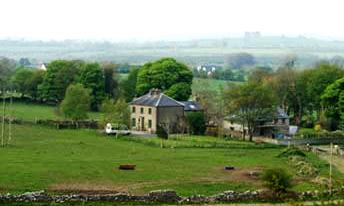
|
| Kilcreevin | Lewis records Kilcreevin as a seat of Jemmett Duke in 1837. Griffith's Valuation shows that Jemmett Duke was leasing over 250 acres from the Coopers of Markree in this townland including a property valued at £2. |
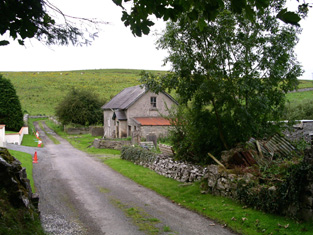
|
| Kilmorgan | Jemmet Duke held 220 acres at Kilmorgan, barony of Corran as well as a property valued at £5 at the time of Griffith's Valuation. Lewis had recorded Kilmorgan as the seat of Robert Weir. McTernan notes that Kilmorgan had belonged to the Trumble family but was sold by them in 1855. The site is now occupied by farm buildings. | |
| Knockalass House | At the time of Griffith's Valuation, Patrick Graham was leasing a house at Knockalass, barony of Corran, valued at £5 together with 75 acres from the Gore Booth estate. McTernan notes that the Grahams were initially tenants and later owners in fee. |

|
| Muckelty | Lewis records Muckelty as the seat of Jones Irwin in 1837. At the time of Griffith's Valuation, Napper Irwin was leasing a property at Muckelty, barony of Leyny, from Henry Irwin. It was valued at almost £3. Farm buildings exist at the site now. | |
| Castle Lodge | At the time of Griffith's Valuation, Richard Beatty was leasing a property valued at £6 from the Fury estate at Ballinphull, barony of Tireragh. McTernan notes that the Fury/Furey family owned this property up to the end of the nineteenth century but did not live there. The Ordnance Survey Field Name Books refer to Castle Lodge as "a handsome cottage in good repair". The house was burned during the Civil War but subsequently repaired. It is still extant but in disrepair. | |
| Kilboglashy | At the time of Griffith's Valuation, Harloe Phibbs was leasing a house valued at £8 as well as mill buildings valued at £300 to Robert Culbertson, at Kiboglashy, Almost all traces of the huge mill complex in Ballysadare have now been demolished and modern building development has taken place there. |

|
| Brick Field | At the time of Griffith's Valuation William Phibbs held a property valued at £6 at Knockbrack, barony of Corran. In 1906 this property was valued at £11. | |
| Markree Observatory | E.J. Cooper was a well-known astronomer and observer of weather patterns. He had this observatory built at Markree c. 1850. It was valued at £40 at the time of Griffith's Valuation. Though now derelict it contains some original features. The archival collection of weather observations taken at Markree is now held by the library of Met Eireann, the Irish meteorological service. |

|
| Keenaghan Mill | At the time of Griffith's Valuation John and Henry Gorman were leasing an extensive milling complex at Keenaghan, barony of Corran from Robert Gore Booth, then valued at £83. |

|
| Tully More House | Edward Perry was leasing a house valued at £5 as well as over 100 acres at Tully More, barony of Tirerrill, from the Cooper estate at the time of Griffith's Valuation. Tullymore House is still extant but unoccupied |

|
| Tully Beg House | At the time of Griffith's Valuation, Matthew Taghney leased a house valued at £1 as well as 51 acres from the Hall Dare estate. This appears to be the house known as Tully Beg House which is still extant. |
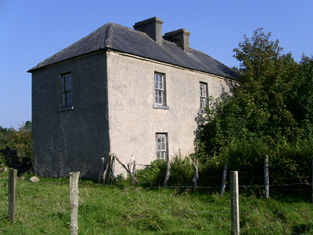
|
| Castletown (Ballysadare) | A house named Castletown appears on the 1st ed. OS Map in the townland of Cloonmacduff. At the time of Griffith's Valuation, Edward J. Cooper owned a gardener's house here valued at £1. The property is now almost completely overgrown. Historians have speculated that this may also be the location of the original seat of Lord Collooney, later acquired by the Coopers. | |
| Greenfield Cottage/Greenville | At the time of Griffith's Valuation, Henry Burrowes was leasing a property valued at almost £8 from the O'Hara estate at Coolaney. This seems to be the property marked on the 1st edition OS Map as Greenfield Cottage. It appears on the 25-inch Ordnance survey of the 1890s as Greenville. The original house is no longer extant. | |
| Somerton | Somerton House appears to have been the residence of the agent to the Perceval estate. At the time of Griffith's Valuation the latter estate was owned by R.W. Hall-Dare. Somerton was then occupied by Christopher L'Estrange and was valued at £14. It is still extant. |

|
| Derroon House | Derroon House is recorded on the 1st edition OS map. At the time of Griffith's Valuation, Capt. Richard Gethin was leasing a property at Derroon from the Gore-Booth estate valued at almost £3. | |
| Greyfort Cottage | At the time of Griffith's Valuation, Nicholas Gardiner was leasing a herd's house valued at £4 and lands from the Nicholson estate. This property is labelled Greyfort Cottage on the 1st edition Ordnance Survey map but it is not shown on the later 25-inch edition of the 1890s. | |
| Leitrim House (Achonry) | The 1st edition OS map indicates "Leitrim House (in ruins)" at Leitrim South, barony of Leyny. At the time of Griffith's Valuation Thomas Kane was leasing 85 acres here from the Ormsby Gore estate though the herd's house on the property only had a valuation of 5s. | |
| Branchfield House (Leyny) | The residence of the McKim family for many generations, Branchfield was enlarged and extended in the later nineteenth century. At the time of Griffith's Valuation it was held from Catherine Gore by Patrick McKim and valued at £5. McTernan states that the lands were sold to the Congested Districts Board in 1910, though the family retained the house. It is currently undergoing renovation. | |
| Templevanny | McTernan notes that Templevanny House was commenced in 1846 but not completed until after the Famine. At the time of Griffith's Valuation, it was held by Margaret and Henry Gorman from Viscount Lorton's estate with a valuation of £2. It continued in the Gorman family until the 1920s. The building is still extant though derelict. | |
| Achonry House | John Docker was leasing Achonry House from the Armstrong estate at the time of Griffith's Valuation, when it was valued at £8. McTernan states that local tradition suggests the house was built by Docker when he leased the property from the Armstrongs. It was subsequently occupied, until the 1930s, by the Gorman family. It is still extant and has recently been renovated. | |
| Altanelvick | A summer residence of the Jones family of Benada. In 1857 held in fee by Daniel Jones and valued at £3. The house became derelict in the twentieth century but has since been restored. | |
| Arnasbrack | Nicholson Ormsby Fury was leasing a house valued at £5 from the Cooper estate at the time of Griffith;s Valuation. McTernan states that it was the modern seat of the Fury family of nearby Castle Fury. In the early twentieth century the family sold their interest in the property. The house is still extant and occupied. | |
| Cuiltybar | Occupied in the eighteenth and early nineteenth centuries by relatives of the O'Haras of Annaghmore. Leased in the 1830s to John Fenton Motherwell and afterwards his widow Elizabeth who held it at the time of Griffith's Valuation. It was then valued at £7 10s and leased to George Martin. It returned to members of the O'Hara family in the early twentieth century after which the land was acquried by the Land Commission. Still extant and occupied, McTernan notes that it is one of the oldest occupied houses in county Sligo and was, in the distant past, known as Trimgrove. | |
| Larkhill | A late nineteenth century house which replaced an earlier residence on an adjacent site. Held by the Greer family from the Perceval estate at the time of Griffith's Valuation, when the house was valued at £1. The property was later acquired by the Bell family who built the existing house. Purchased in the twentieth century by the Taylor family and still extant and occupied. | |
| Quarryfield | McTernan notes that Robert Howes of Bunninadden and Quarryfield married Jane Irwin of Mount Irwin in 1754. Subsequently the then house at Quarryfield alternated between Howes and Irwins. In the 1840s the property was purchased by Col.Perceval of Templehouse and later in the nineteenth century by the Coopers of Markree, by whom the present house was built in 1887. The house had a number of owners since and is still extant and occupied. |
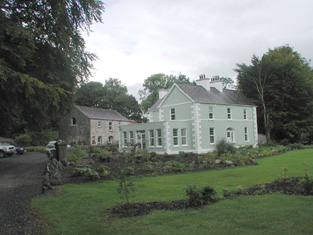
|
| Thornhill (Ballinacarrow) | At the time of Griffith's Valuation, Charles Gilbert was leasing a house and bleach mill at Ballinacarrow North, from the Hall Dare (earlier and later the Perceval) Estate. The combined valuation of the buildings was over £21. McTernan states that this is Thornhill House and mills. The mills had ceased to operate in the early twentieth century but the house is still extant. | |
| Crohy House | Crohy House was occupied by Francis Foster, leasing from the Conyngham estate at the time of Griffith’s Valuation. | |
| Roshin Lodge | Francis Foster was occupying Roshin Lodge at the time of Griffith’s Valuation. It was leased from the Conyngham estate and valued at £18. Foster's daughter, Mary Stewart Foster, married John Stouppe Charley of Belfast. She sold the property after his death. In 1876 it was offered for sale by Arthur Sandys Forster. Roshin Lodge was described as 'a spacious dwelling house, comprising 29 apartments' at that time. By 1901 it was the residence of William Smyth and his family. He had died by 1911 but his widow and children still occupied the property. |

